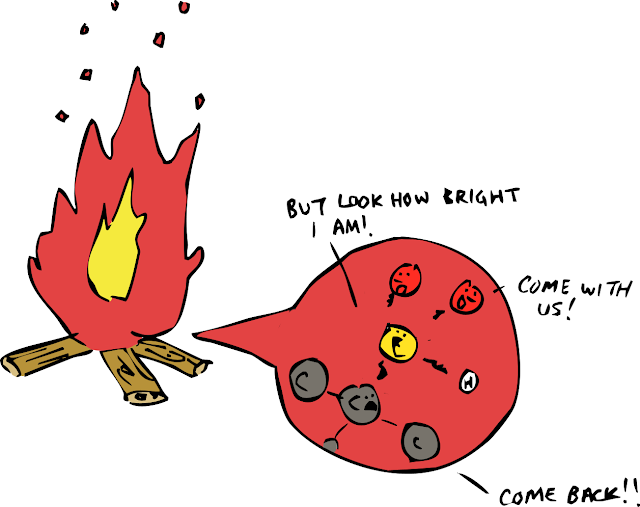The holidays are about ambiance. If you can’t surround
yourself with the right festive atmosphere, then it will take much more of an
effort to get into the spirit of the season. Obviously, decorations and a
Christmas tree (or menorah or Festivus pole, depending on your leanings) go a
long way to setting the mood; but nothing quite matches a crackling fire for creating
warm and cozy feelings in the cockles of your heart.
The problem with fire is that it is difficult to manage and
generally a pain in the butt. If you don’t keep it under control, it will burn
up your presents and send you to the hospital. If you don’t constantly stock
it, your fire will burn itself out and leave you shivering in the cold. That is
probably why as human civilization has developed, we’ve outsourced our
fire-making to power plants. But even if we are a lazy bunch of spoiled brats,
we’ve never lost our love for just being in the presence of flames. Why else
would they have an endless loop of a burning log on Netflix during December?
Streaming may be more convenient, but starting your own fire
brings a sense of accomplishment and the effect is much more authentic. With
that in mind, let’s dive into what makes a good fire.
First, most of us know that fire needs three elements: heat,
fuel, and oxygen.
The interesting thing about fire
is that it is not a thing by itself; rather, it’s more of an event. It is the
outcome of taking a piece of matter containing compounds that react with oxygen and then
heating them up enough so that they can combust. These compounds generally
include hydrogen and carbon. Flames themselves are just super-heated carbon
atoms that give off light as they rise away from the base of the blaze.
For our purposes, a fire starts when you heat up a piece of
wood to a temperature where cellulose (the stuff wood is made of) begins to
break down. As it does so, it releases gases containing reactive compounds. As
heated molecules in cellulose are exposed to the oxygen in the surrounding air,
they break apart and create new bonds, generally producing water and carbon
dioxide. As atoms recombine, they rise and give off heat. The reason flames taper
off into a point is that as the gases in the fire rise, they gradually spread
out and begin to cool down. The tip of a flame is the last point at which they
are close enough together for some atoms to still glow (incandesce).
Okay, so now we know what fire is, but how to we get one
started? First, you have to pick the kind
of wood you want to burn, as not all woods
are created equal. Hardwoods like ash, oak, beech, and apple are dense, so
they burn hot and last a long time; however, they are tough to heat to ignition
temperature and they lack the satisfying crackle that a good Christmas fire
needs. The reason they are dense is because the trees from which these woods
come grow slowly with few air or water pockets between the wood fibers. By
contrast, softwoods like pine, light easier and crackle like a cereal elf, but
they burn quickly and the liquid sap they contain can create a flammable build-up in
your chimney. The best choice for Christmas, then, is fir. Woods like Douglas
fir are moderately dense, they crackle, and they have less sap.
The key to getting your fire going is in the shape of the
wood, and the key factor in shape is surface
area. To heat up enough cellulose to start the self-perpetuating
chemical reaction we’re going for, we’ll want to start with pieces of wood with
a larger surface area. This means that as much of their mass as possible is
exposed to the oxygen with which we are trying to get it to react. To help you
visualize what I’m talking about, imagine a piece of paper so large that it
weighs 10 lbs (4.5 kg). It has a large surface area and will burn much faster
and light much easier than a block of wood that weighs 10 lbs.
Once you get your fire going and it is generating enough
heat on its own, you can throw in pieces with decreasing surface areas until
eventually you can burn a big yule log. A big, slow burning piece of dense wood
will keep you warm and entertained for hours as you drink your eggnog and revel
in holiday cheer.
Now, get to roasting those chestnuts.








5 comments:
Nice Post
My dad was the one who taught us the basics of starting a fire when we were around 10 years old. It was that time when we were already so engrossed in camping and trekking. We often tag along with the adults so my dad decided it's time to learn some basic survival techniques. For a 10 year old, it was pretty interesting and empowering since igniting a fire from scratch is really cool in those days. I think it's a great bonding opportunity for parents and their kids. Now, it's my turn to teach my kids. For more how tos, see: http://backpackingmastery.com/skills/how-to-start-a-fire.html
I remember once at urban night feast I set the New Year tree on fire. That was the most exciting yet horrifying experience of my life. It's a good luck that we put the fire away before the house burnt to ashes.
cheap jordans
lacoste polo shirts
lebron shoes
kyrie 4
pandora jewelry
jordan 4
yeezy shoes
adidas ultra boost
ralph lauren uk
balenciaga shoes
westbrook shoes
converse outlet
balenciaga shoes
nhl jerseys
yeezy boost
nike air max 95
nike shoes
kevin durant shoes
golden goose
birkin bag
Post a Comment